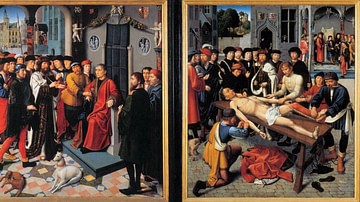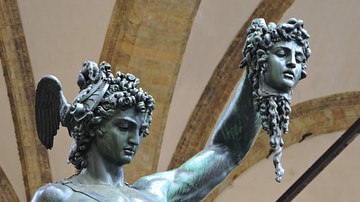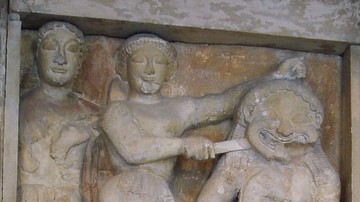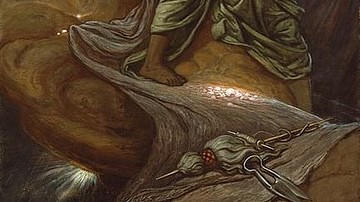
Medusa is a figure from Greek mythology, the only mortal of the three Gorgons, along with her immortal sisters, Stheno and Euryale. The three Gorgons were born to the sea god of the dangers of the hidden deep, Phorcys, and the goddess of sea monsters and the dangers of the sea, Ceto.
According to Hesiod in his Theogony, Medusa and her sisters were the sisters of the Graeae and lived "beyond framed Oceanus at the world's hard edge by Night, where the clear-voiced Hesperides are" (Theogony, 270). The three sisters are often mentioned together, but it is Medusa who is commonly depicted in both ancient Greek literature and art. The name Gorgon comes from the ancient Greek word γοργός, meaning "grim," "fierce," and "terrible," and Medusa's name derives from the ancient Greek verb μέδω meaning "to guard" or "to protect," which is very fitting given the apotropaic quality of the face of the Gorgon, known as the Gorgoneion.
Medusa is best known from the story of her death, brought upon her by the hero Perseus who decapitated her with the help of the gods Hermes and Athena. The earliest version of Medusa's death is from Hesiod's Theogony, which details her decapitation and describes her children Pegasus, the winged horse, and the great Chrysaor, who sprung from her neck. Mentions of the head of the Gorgon in Homer's Iliad and Odyssey, which were originally part of the Greek oral tradition before being committed to writing sometime in the 8th century BCE, hint at a long history of the story of the complex character of the Gorgon Medusa.
Perseus & Medusa
Over time, Medusa's tale changed between the myriad ancient writers and poets who wrote about her story. She is best known for her hair of snakes and her ability to turn people to stone with a single look. The 8th-century BCE poet Hesiod describes how Poseidon had sex with Medusa in a soft spring meadow, and Ovid (43 BCE to 17 CE), the Roman poet some 700 years later, relates how Medusa was violated in a shrine to Minerva (the Roman equivalent of Athena) by Neptune (the Roman equivalent of Poseidon), and how, in retaliation for desecrating her shrine, Minerva turned Medusa's lovely hair into snakes. Generally speaking, earlier poets depicted Medusa as a monster from birth, alongside her immortal sisters, but later writers say she began as a beautiful maiden but was turned into a monster by Athena or Minerva.
Medusa is best known for her death at the hands of Perseus, and Pseudo-Apollodorus relates the story in the greatest detail. According to him, Perseus was the son of Zeus, who took the form of a shower of gold), and Danaë, who had been locked up by her father Acrisius after he was told by an oracle that he would be killed by Danaë's son. When Acrisius learned that Perseus had been born and was the son of the king of the gods, he put both Danaë and her son Perseus into a chest and hurled it into the sea. The chest eventually came ashore at the island of Seriphos, and Perseus was raised by Dictys, the brother of Polydectes, the king of Seriphos. Polydectes fell in love with Danaë, but Perseus was quite protective of his mother, and so the king made a plan to trick Perseus. He gathered his people to a banquet under the ruse of collecting contributions for the marriage of Hippodamia, who tamed horses. When Perseus arrived without horses for a gift as was requested by Polydectes, Polydectes instead asked Perseus to retrieve for him the head of Medusa, the only mortal Gorgon, in the hopes that he would not succeed.
Perseus was guided by the god Hermes and the goddess Athena on his journey. It is said that Athena helped in the killing of Medusa because the girl had been willing to have her beauty compared to Athena. By some nymphs, the hero was given winged sandals, a sack known as a kibisis to store the head of the Gorgon, and the invisibility cap of Hades. Additionally, Hermes had given him an adamantine sickle. Perseus arrived at the home of the Gorgons while they slept. As he stood over the sleeping creatures, Athena guided Perseus' hand while he looked into the reflection of a bronze shield so as not to be turned to stone by the gaze of the Gorgons if they awoke, and he cut off the head of Medusa with the sickle. From her severed head sprang Pegasus, the winged horse, and Chrysaor. Perseus placed the head of Medusa in his kibisis, but as he was leaving, the remaining two Gorgons woke up and tried to pursue him, but since he was wearing the invisible cap, they could not see him.
Medusa’s Head
After slaying Medusa, Perseus uses her head multiple times. Some versions of the tale of Ariadne, Theseus, and Dionysus say that Ariadne was killed by Artemis, and others say that she was accidentally turned to stone by Perseus after Dionysus made war on Perseus. Another use of Medusa's head was to save Andromeda, who had been tied to a rock as an offering to the sea monster Ketos. Her mother had claimed she was more beautiful than the Nereids, who flew into a rage upon hearing this and had Poseidon, the god of the sea, on their side. The only way to stop the sea god's floods and the sea monster was to give up Andromeda. Perseus fell in love with her the moment he saw her; he slew the sea monster and set her free. The only issue was that Andromeda was already engaged to be married to her uncle Phineus. Perseus made short work of Phineus by turning him to stone with the head of Medusa. When Perseus returned to the Island of Seriphos, he turned Polydectes and his people to stone with the Gorgon's head and made Dictys the king. Then he gave the head of Medusa to Athena, who placed it in the centre of her shield, known as the aegis, to terrify her enemies.
The Transformation of Medusa in Literature & Art
There was no uniform description of Medusa and her fellow Gorgons, and her characteristics transformed across writers and regions. Hesiod, in his Theogony, does not mention any physical features of the Gorgons, but Homer, in his Odyssey, mentions "the monsters head, the Gorgon" (11.636), and in the Iliad, he describes the Gorgoneion on Athena's aegis as "the head of the grim gigantic Gorgon, a thing of fear and horror" (5.741-742). Aeschylus, the 6th/5th century BCE tragedian, describes the women in his Greek tragedy Prometheus Bound as the "three winged sisters, loathed enemies of humankind, the snake-haired Gorgons, whom no man can see and live" (798-799). Then there is Pindar, who, in his Twelfth Pythian Ode, mentions the "fierce Gorgon's deathly dirge," the "snaky heads of the maidens" and the head of the "beautiful-cheeked Medusa" (12.7-16). Pindar also tells us of Athena's invention of the aulos in order to recreate "with instruments the echoing wail that was forced from the gnashing jaws of Euryale" (12.20-21) as Medusa's immortal sisters pursued her killer.
Later in the Roman period, we have the Greek writer Pseudo-Apollodorus, who described them with "heads with scaly serpents coiled around them, and large tusks like those of swine, and hands of bronze, and wings of gold which gave them the power of flight; and they turned all who beheld them to stone" (11.4). According to Ovid in his Metamorphoses, which is the main source for the beautiful-maiden-turned-monster narrative, it was only Medusa of the three Gorgons who had snakes for hair. He tells the story of how Medusa, who had an enviable head of hair, was pursued by many suitors until she was raped by Neptune inside a shrine to Minerva, after which the goddess punished Medusa by transforming her beautiful hair into snakes. As Perseus moved towards the home of the Gorgons, he passed many statues – men and beasts turned to stone by Medusa – before he cut off her head while she slept.
As Medusa was described differently in literature, from a hideous beast to a beautiful maiden, so she was depicted differently in ancient Greek art. The head or face of Medusa was a common feature of Greek pottery, art, and architecture, and is known as a Gorgoneion. What was so unique about her depiction is that more often than not she was depicted facing front. This is quite uncommon compared to most other ancient Greek art, where faces were depicted in profile. In the Archaic Period, from the 8th to the early 5th centuries BCE, the Gorgoneion could be found on temple pediments and antefixes, in statues, and in pottery. She was depicted with a large round face, a beard, fangs or tusks, wings, and often with an open mouth and stretched tongue.

Medusa continued to be depicted on vessels and pottery, and even on shields and breastplates, facing front with wild hair, but her features became more feminine and human-like over time. Medusa can be found all over ancient Greek, Hellenistic and Roman art, and as she became more human-like primarily on ancient Greek pottery, she often still retained the wings, especially if her whole body was depicted. The image of Medusa's face and, in particular, her death became not only a popular image but also the Gorgoneion became an apotropaic device, meaning that the image was believed to be able to ward off evil.









